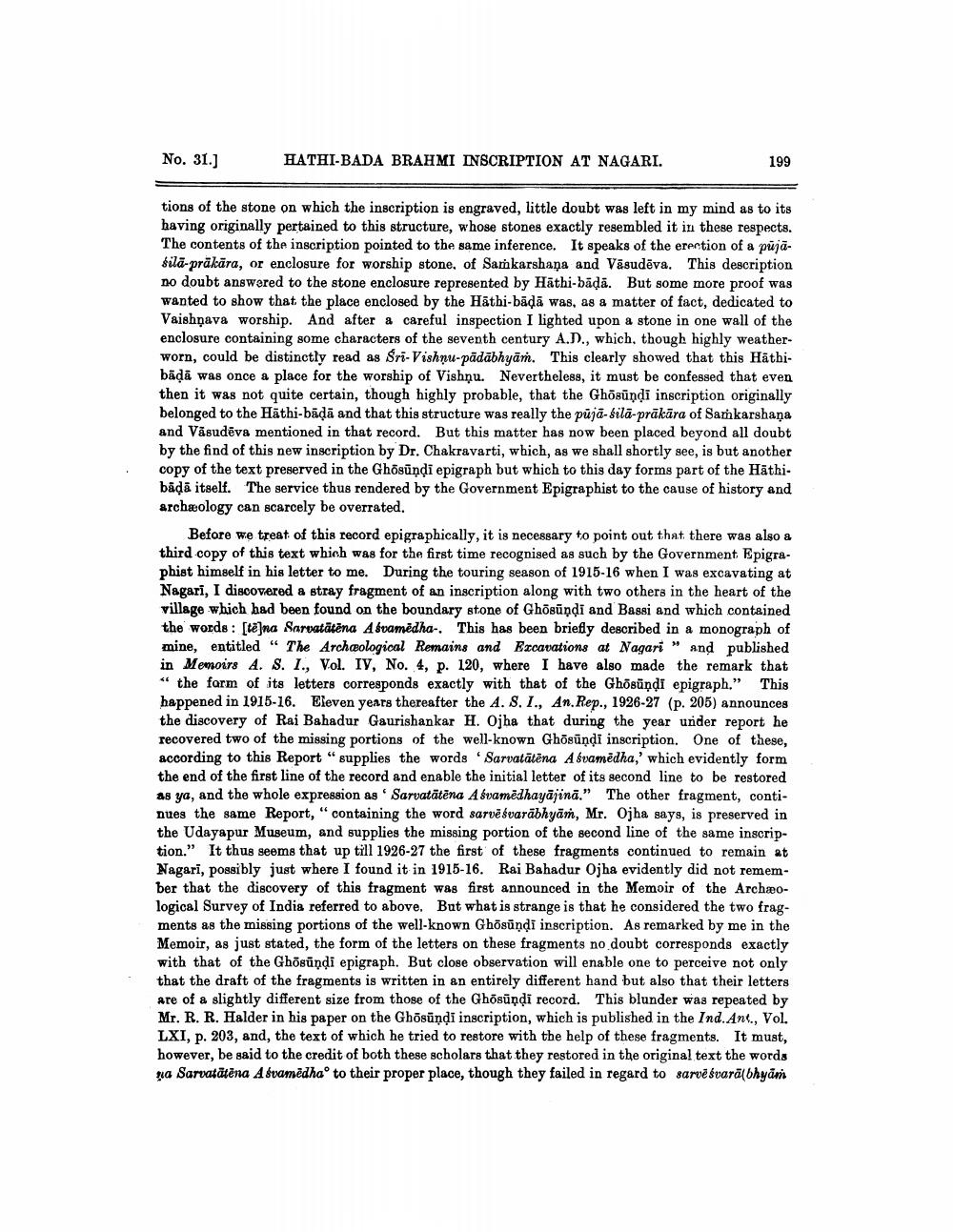________________
No. 31.)
HATHI-BADA BRAHMI INSCRIPTION AT NAGARI.
199
tions of the stone on which the inscription is engraved, little doubt was left in my mind as to its having originally pertained to this structure, whose stones exactly resembled it in these respects. The contents of the inscription pointed to the same inference. It speaks of the erection of a pūjāšilā-prākāra, or enclosure for worship stone, of Samkarshaņa and Vāsudēva. This description no doubt answered to the stone enclosure represented by Hāthi-bādā. But some more proof was wanted to show that the place enclosed by the Häthi-bādā was, as a matter of fact, dedicated to Vaishộava worship. And after a careful inspection I lighted upon a stone in one wall of the enclosure containing some characters of the seventh century A.D., which, though highly weatherworn, could be distinctly read as Sri-Vishnu-pādābhyām. This clearly showed that this Häthibādā was once a place for the worship of Vishnu. Nevertheless, it must be confessed that even then it was not quite certain, though highly probable, that the Ghosündi inscription originally belonged to the Häthi-bādā and that this structure was really the pūjā- Silā-prākāra of Samkarshaņa and Vāsudēva mentioned in that record. But this matter has now been placed beyond all doubt by the find of this new inscription by Dr. Chakravarti, which, as we shall shortly see, is but another copy of the text preserved in the Ghosūņdi epigraph but which to this day forms part of the Hāthibādā itself. The service thus rendered by the Government Epigraphist to the cause of history and archaeology can scarcely be overrated.
Before we treat of this record epigraphically, it is necessary to point out that there was also a third copy of this text which was for the first time recognised as such by the Government Epigraphist himself in his letter to me. During the touring season of 1915-16 when I was excavating at Nagari, I discovered a stray fragment of an inscription along with two others in the heart of the village which had been found on the boundary stone of Ghosūņdi and Bassi and which contained the words : [tē]na Sarvatātēna Asvamēdha-. This has been briefly described in a monograph of mine, entitled “The Archeological Remains and Excavations at Nagari and published in Memoirs A. S.I., Vol. IV, No. 4, p. 120, where I have also made the remark that " the form of its letters corresponds exactly with that of the Ghősündi epigraph." This happened in 1915-16. Eleven years thereafter the A. S.I., An. Rep., 1926-27 (p. 205) announces the discovery of Rai Bahadur Gaurishankar H. Ojha that during the year under report he recovered two of the missing portions of the well-known Ghosūņdi inscription. One of these, according to this Report "supplies the words 'Sarvatātēna Abramëdha,' which evidently form the end of the first line of the record and enable the initial letter of its second line to be restored as ya, and the whole expression as Sarvatātēna A évamëdhayājinā." The other fragment, continues the same Report,"containing the word sarvē svarābhyāṁ, Mr. Ojha says, is preserved in the Udayapur Museum, and supplies the missing portion of the second line of the same inscription." It thus seems that up till 1926-27 the first of these fragments continued to remain at Nagari, possibly just where I found it in 1915-16. Rai Bahadur Ojha evidently did not remember that the discovery of this fragment was first announced in the Memoir of the Archæological Survey of India referred to above. But what is strange is that he considered the two fragments as the missing portions of the well-known Ghosūņdi inscription. As remarked by me in the Memoir, as just stated, the form of the letters on these fragments no doubt corresponds exactly with that of the Ghősündi epigraph. But close observation will enable one to perceive not only that the draft of the fragments is written in an entirely different hand but also that their letters are of a slightly different size from those of the Ghosūņdi record. This blunder was repeated by Mr. R. R. Halder in his paper on the Ghosündi inscription, which is published in the Ind. Ant., Vol. LXI, p. 203, and, the text of which he tried to restore with the help of these fragments. It must, however, be said to the credit of both these scholars that they restored in the original text the words na Sarvatātēna A svamēdhao to their proper place, though they failed in regard to sarve svarā(bhyan




